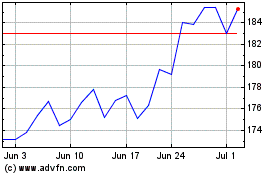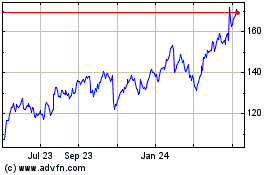By Robert Wall and Andy Pasztor
The quick development of pilotless aircraft has captivated
throngs of industry executives with its possibilities, promising
services like drone-based package delivery, rescue drones and drone
taxi services.
For now, though, that commercial promise has been overshadowed
at times by incidents like the one this week at the U.K.'s Gatwick
Airport. Authorities have grounded flights off and on for three
days, closing the runway all of Thursday after unauthorized drone
operations nearby. Officials said it was a deliberate attempt to
disrupt travel.
The fiasco struck at a time when companies such as Amazon.com
Inc., Google parent Alphabet Inc. and others have bet big on
drones. They are developing services as diverse as package delivery
and communications broadcasting. Many of these companies, however,
have little experience with the historically slow pace of crafting
aviation rules. The Gatwick incident is a sobering reminder of the
long road ahead to making such drone-based businesses a reality,
without imperiling commercial flights.
"People have now started to realize how useful drones can be,
but there has to be a good regulatory framework," said Marc
Kegelaers, chief executive of Antwerp-based
drone-air-traffic-management provider Unifly NV.
Underscoring the push for a convergence between drones and
airlines, DFS Aviation Services GmbH, a state-owned company that
manages Germany's air traffic-control system, on Friday said it had
agreed to buy a 23% stake in Unifly. DFS Chief Executive
Klaus-Dieter Scheurle called it a step toward "harmonious and safe
coexistence of manned and unmanned aviation."
But experts see even partial integration as many years away, and
dependent on technical leaps still on the drawing boards.
Some drone proponents worry the Gatwick incident could lead to
regulatory backlash. The British Airline Pilots Association, which
has long called for tighter rules for private drone use, this week
called on the British government to increase to five kilometers
(3.1 miles) from one kilometer the drone exclusion zone around an
airport. It also called for drone licensing and registration
requirements and for drones to be equipped with aircraftlike
transponders so they can be tracked.
Nearly 80,000 registered commercial drones are flying in the
U.S. already. That is projected to climb to 1.6 million by 2021.
Industry officials envision that one day a single pilot might be
controlling a flock of drones from long distances, possibly doing
everything from crop dusting to inspecting railroad tracks.
Law-enforcement and security agencies have been ambivalent about
many of the ambitions behind that vision. The U.S. Federal Bureau
of Investigation has said civilian drones pose a steadily
escalating threat to U.S. security.
"Terrorist groups could easily export their battlefield
experiences to use weaponized drones" against civilian targets, FBI
Director Christopher Wray told a Senate panel in October.
The U.S. Federal Aviation Administration wants the FBI to sign
off on proposed ways to remotely identify drones. The preliminary
standard is scheduled to be released early next year.
"New aviation technologies are usually ahead of the regulatory
framework, " Patrick Ky, executive director of the European
Aviation Safety Agency, the equivalent of the FAA, said this month.
Basic parameters -- such as how much noise and intrusion on privacy
will citizens tolerate with expanded drone usage -- need to be set
against the economic benefit of new business opportunities before
regulators can start to hand down design specs for commercial
drones.
A split in the drone industry itself about how to proceed has
made drafting rules more difficult. Proponents of recreational
drones, led by China's DJI, the world's largest civilian drone
maker, are pushing for relatively simple, onboard systems to
identify operators and transmit location and other information to
conventional cellphones or company-provided technology. Consultant
Jim Williams, the former head of the FAA's drone integration
office, compares it to an electronic license plate.
Other commercial drone backers see a need for more complex
communication networks, such as independent air-traffic-control
systems using the internet as a backbone and tailored to
low-altitude operations across cities and regions.
"There is frustration that industry is just incapable of coming
up with a consensus," said Kenneth Quinn, a former senior U.S.
air-safety regulator who is now co-chair of the unmanned aircraft
systems practice at law firm Baker McKenzie LLP.
Christoph Raab, executive director of Drone Alliance Europe, an
industry group, said the Gatwick incident could boost backing for
European efforts to identify and track drones. "If the system is
properly put into place, a cat-and-mouse game like [Gatwick] should
not be possible," Mr. Raab said.
While regulators race to keep up with the unmanned aircraft
industry's growth, they are also being pressured by their
governments to not be left behind by other countries' progress.
The Trump administration has been particularly sensitive to such
concerns, convening several White House and agency sessions to
promote the U.S. industry, while launching pilot programs across
the U.S. to showcase cutting-edge hardware and remote tracking
options.
The European Union estimates the commercial drone business could
generate EUR10 billion ($11.4 billion) a year in annual revenue. EU
Transport Commissioner Violeta Bulc has championed the drone
industry. The European Commission is very committed to developing a
drone services market, she said in October.
"We really are in a race, Europe versus the various parts of the
world," Unifly's Mr. Kegelaers said.
Write to Robert Wall at robert.wall@wsj.com and Andy Pasztor at
andy.pasztor@wsj.com
(END) Dow Jones Newswires
December 21, 2018 15:49 ET (20:49 GMT)
Copyright (c) 2018 Dow Jones & Company, Inc.
Alphabet (NASDAQ:GOOGL)
Historical Stock Chart
From May 2024 to Jun 2024

Alphabet (NASDAQ:GOOGL)
Historical Stock Chart
From Jun 2023 to Jun 2024
